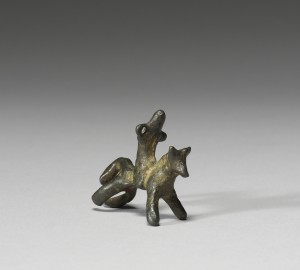
In eighth century Francia, the setting for my novels, the nobility had their own version of age appropriate, educational toys and games. The play weapons and miniature soldiers for boys were not merely a means to indulge fantasy.
When noble parents gave their 3-year-old son a wooden sword, they expected him to wield an iron one in a few years. And I do mean only a few years, if we are to believe the annals. Childhood did not last long.
Charlemagne was 13 during his first campaign against Aquitaine in 761 with his father, King Pepin. His son Charles (called Karl in my books) was about 11 or 12 in the 784 battles against the Saxons, and as part of an effort to intimidate the duke of Bavaria, Charles’s son Pippin of Italy (spelled this way in self-defense) was about 10 when asked to march an army to Trent in 787, although he did not accompany the soldiers all the way to Balzano. The boys probably led the forces in name only, but taking them even near the battlefield isn’t exactly keeping them out of harm’s way.
So I can imagine medieval fathers taking their sons’ hands and saying “Hold the hilt like this” and “Move your feet like the way you dance.”
As noble boys got older, their games included archery and simulated combat. To learn to hit a target correctly, they aimed a lance at a manikin with a shield. If the blow was not true, they’d be smacked with a bag of flour.
When it came to the pastime of hunting, young boys wanted to be part of the dangerous sport. In 826, 3-year-old Charles (named after grandfather Charlemagne) imitated his father, Louis. When the child spotted the prey, he called for his horse and a quiver of arrows. His mother and tutor had to literally hold him back. Never fear, though. The young animal was caught and brought to the prince, says the poet Ermold, and “he seized weapons of his own size and struck the trembling beast.”
Even indoor forms of play served a purpose. Toy soldiers made of silver, gold, or bronze and board games similar to chess and backgammon were both good at developing strategy. Aristocratic boys were going to grow up to lead common soldiers, conscripts who would get most of their training on the battlefields. The future lords needed to know how to think.
Sources
Daily Life in the World of Charlemagne, Pierre Riche, translated by Jo Ann McNamara
Carolingian Chronicles, Royal Frankish Annals and Nithard’s Histories, translated by Bernhard Walter Scholz with Barbara Rogers
Daily Life in the Age of Charlemagne, John J. Butt
– Kim Rendfeld is the author of two novels set in the early days of Charlemagne’s reign: The Cross and the Dragon (2012, Fireship Press), in which a young noblewoman must contend with a jilted suitor bent on revenge and the anxiety her husband will die in the coming war, and The Ashes of Heaven’s Pillar (2014, Fireship Press), a tale of a peasant mother who will go to great lengths to protect her children after she has lost everything else. You can read the first chapter of either book, read excerpts of reviews, and learn more about Kim at kimrendfeld.com. You can also visit her blog Outtakes of a Historical Novelist at kimrendfeld.wordpress.com, like her on Facebook at facebook.com/authorkimrendfeld, follow her on Twitter at @kimrendfeld, or contact her at kim [at] kimrendfeld [dot] com.


